Spring is a gorgeous time in the outdoors, and it can really keep us nature-lovers busy! However, it’s a vanishingly short time. It seems like we’ve just removed our winter jackets when suddenly summer heat calls for sunscreen. Among the many signs of spring, spring ephemerals are one of the most beautiful and fleeting.
Just like Spring itself, these special wildflowers bring sudden, lush beauty to the landscape. Also just like Spring, they are gone before we know it! Because of that, it can be difficult to spot them, but their beauty is well worth the effort. In this Wildlife Spotlight post, let’s learn about these unique plants and some tricks for a better shot at meeting them in person.
The Ephemeral Lifestyle

The word “ephemeral” comes from the Greek words epi (“on”) and hemera (“day”). Consequently, we use it to describe things that are short-lived, or that only last a day. For example, the common belief that butterflies only live for two days implies that they are ephemeral.
Ephemeral species live life in the fast lane—or at least they seem to. In other words, these organisms complete their life cycle in a short amount of time. For ephemeral plants, this often means having a very quick flowering period. The plant grows rapidly at the opportune moment, blooms, creates seeds after being pollinated, and disappears.
Many plants live this short-term lifestyle, wherever the conditions for growing are short-lived. For example:
- Deserts, where its only wet for a short time
- Flooded areas, where species need to reproduce in an aquatic environment
- Disturbed habitats, where conditions change rapidly due to the growth of new vegetation
Jewels of the Forest
Spring ephemerals have adopted their lifestyle for a different race against time. In deciduous forests, trees lose their leaves each winter and don’t grow them back until late in the Spring. Once those leaves come out, they hog all of the available sunlight. This is why forests often feel so much more dark, calm, and cool even on a hot day.

While this is great for hikers and naturalists who want to rest or do a sit spot, it’s not so good for small flowering plants. Since plants use the sun to get food and energy, getting shaded out at the wrong time can mean starvation. Because of this, Spring ephemerals set an aggressive pace. Specifically, they try and sprout, bloom, get pollinated, and set seed all before the slower trees can put out leaves!
Once they have set seed, spring ephemerals die back and disappear again into the forest floor. This means that if you don’t act fast, you’ll miss them completely! By the time the forest trees have leafed out in all their green majesty, only shade-tolerant flowers will remain. The window for seeing them is thus only a couple weeks to a month of the year!
Sheltered living

So, if living in the forest presents so many problems, why do it? Many other wildflowers thrive in meadows and other open areas where they can get all of the sunlight they need. These are often familiar to us as popular garden plants. As it turns out, there are some distinct advantages to life in the forest:
- Trees moderate temperatures, preventing hot and cold extremes.
- Leaf litter holds in moisture and enriches the soil, making it ideal for growth.
- Surrounding woods protect from strong winds, reducing air movement, making it safe for delicate plants.
- A vibrant underground network of fungi called mycorrhizae provide support and connection between plants, including wildflowers and trees.
Hidden secret
However, most spring ephemerals don’t actually die off at that time. In fact, the majority of temperate spring ephemerals are perennial plants. This means that they stay alive and flower for multiple years. But, if they’re around all year, why do we only see their flowers for a few weeks each spring?
As it turns out, they stay alive underground. Spring ephemerals use below-ground organs like corms, rhizomes, or bulbs to store their energy over Fall and Winter. That way, they can store up the suns energy before the trees regrow their leaves, and use it to flower the next year.
Help from their friends

This opportunistic lifestyle isn’t easy, and presents plenty of problems. For example, by blooming before the trees, spring ephemerals are also blooming before most pollinators come out of hibernation. Fortunately, many of them have specific early-arriving insects as pollinators. These bugs are active at the right times to help spring ephemerals reproduce. It’s a match made in heaven! These include:
- Ants
- Fungus gnats
- Miner bees (genus Andrena)
- Bumblebees
Some species, like bloodroot (Sanguinaria canadensis) also employ ants to disperse their seeds. They surround their seeds with a fleshy, nutritious coating called an elaiosome. High in protein and fat, the elaiosome is too tempting for ants, who carry it back to their nest. Next, the ants discard the bloodroot’s seed in their refuse piles on the forest floor, which provide a perfect nursery! There, the young bloodroots can grow in ideal conditions with plenty of organic matter for nutrients.

The forests’ underground network of fungi, the mycorrhizae, are also a big help to spring ephemerals. These fungi can actually move valuable nutrients and sugars (food!) back and forth between different plants to help them stay alive. Research demonstrates that spring ephemerals can exchange nutrients with one another and nearby trees via this trade-web. This probably plays a big role in keeping them alive during dormant months
Examples of spring ephemerals

Spring ephemerals are usually small in stature and delicate to the touch. Secondly, they are often very beautiful, if tiny and understated. Many spring ephemerals from Europe will be familiar not only to Europeans and folks in the United Kingdom, but also to North Americans. This is because many of those European and British species were domesticated as popular garden plants. These include:
- Daffodils (Narcissus sp.)
- Crocuses (Crocus sp.)
- Hyacinths (Hyacinthus sp.)
- Tulips (Tulipa sp.)
You may notice that people tend to exchange these plants as cheerful, potted gifts in early Spring. The timing of these gifts might tell you something about their origin!
For better or worse, fewer of our North American spring ephemerals have been domesticated. In the East, you might encounter species like:
- Bloodroot (Sanguinaria canadensis)
- Spring beauty (Claytonia sp.)
- Trout lily (Erythronium americanum)
- Hepatica
- Dutchman’s breeches (Dicentra cucullaria)
- Trillium
- Bluebells (Mertensia sp.)
Out West, you’re more likely to see species like:
- Calypso orchid (Calypso bulbosa)
- Lupines (Lupinus sp.)
- Glacier lily (Erythronium grandiflorum)
- Yellowbells (Fritillaria pudica)
- Bitterroot (Lewisia rediviva)
- Sagebrush buttercup (Ranunculus glaberrimus)
- Shooting-stars (Dodecatheon sp.)

How to see spring ephemerals
As you might guess, finding spring ephemerals can be challenging. Since they’re here-and-gone-again before you know it, it pays to be a little strategic. Here are some tips for getting your best chance a seeing these beautiful wildflowers:
Look for older stands of forest
Their fleeting growth period means that spring ephemerals take a long time to establish themselves. This means that older stands of trees will be more likely to harbor them. Look for mature forests with taller trees and larger areas of intact forest floor.
Go out frequently after snowmelt and sunny days in early spring

Spring ephemerals often bloom in response to ground temperature. In other words, their phenology or timing is heavily based on how warm their forest floor environment is. Specifically, the warmest period for forest soils is often their key period before the trees have leafed out, and when spring sunshine arrives. When days like these start coming, and when most evenings are above freezing, start your search! Going out once or twice a week will make it harder to miss these short-lived beauties.
Try walking at different elevations

Their temperature sensitivity makes spring ephemerals very sensitive to differences in temperature. As you might imagine, temperatures tend to be a little lower at higher elevations and at higher latitudes. This means that there will be a delay in flowering time for spring ephemerals in these locales. So, if you’re looking for the first spring ephemerals, visit lower-elevation places that are further South first.
Go out when the weather is nice

Having very little time to do their work, spring ephemerals are picky about the weather! Many species will not open their flowers unless it is a warm, sunny day. If it’s cool or raining, they are likely to wait until conditions are better for their pollinators to be active. By going out on pretty days, you’re more likely to meet them at their finest.
Nature’s time machine

Did you miss the spring ephemerals in your area? Is it already the middle of spring and leaves have come out? Don’t worry! It’s not too late! If you’ve got the time and energy, you can always use the climate time machine and turn back the clock. By hiking up to higher elevation forest or heading North, you’ll find forests that are behind your area. If you’re lucky, these may be in the perfect window for the plant you want to see!
I used this approach last year and got to see a bunch of wildflower species I was afraid I had missed while travelling.
Thanks for reading about spring ephemerals!
What’s your favorite spring ephemeral in your neck of the woods? Let us know in the comments! If you’d like to learn more, check out the Nature Guys Podcast episode on Spring Wildflowers.

